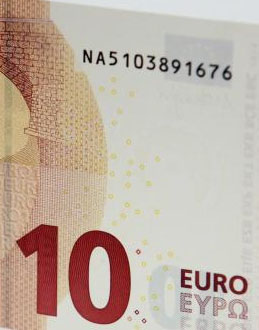New Europa series of banknotes.
1. Why is this new series of banknotes being introduced? What purpose does it serve?
The ECB and National Central Banks (NCBs) are responsible for the integrity of euro banknotes, in other words for the quality of the banknotes in circulation and their resistance to counterfeiting. This new series of banknotes is being introduced in order to ensure that the general public retains its confidence in the currency in the long term. Banknotes must be upgraded on a regular basis if they are to remain easy to authenticate and to counteract counterfeits, which also capitalise on technological developments. The Eurosystem therefore planned to launch a new series with redesigned security features as of 2002 so as to stay one step ahead of counterfeiters. It took advantage of the opportunity to make the banknotes more user-friendly, in particular for the visually impaired, and to enhance the durability of smaller denominations.
2. Is there a cut-off point for using old banknotes? And after that, will they retain their value? Can they be exchanged for new banknotes at the bank?
The second series will be introduced gradually (at a rate of one value per year approximately), and the old series will remain legal tender for several years. It was decided that the new banknotes should be issued in ascending order, so the €5 was the first denomination to be circulated. The other denominations will follow at regular intervals, with the €10 being introduced on 23 September 2014, then the €20, and so on.
The old and new series will circulate in parallel for a few years and will both be legal tender. After this, banknotes from the first series will gradually be withdrawn from circulation by the NCBs and will cease to be legal tender as of a date to be announced well ahead of time. Once they cease to be legal tender, these first series banknotes will no longer be a valid form of payment but they will retain their value indefinitely and can therefore be exchanged at any time for second series banknotes at the Banque de France or at the other euro area NCBs.
3. Monaco is not part of the European Community. Since the Principality does not belong to the Eurosystem, how will the new Europa series of banknotes be implemented in Monaco?
Until the end of 2001, the French franc was used in Monaco on the basis of a monetary agreement with France.
When the franc disappeared, it was replaced by its successor, the euro, under a new monetary agreement between the French government, on behalf of the European Community, and the government of His Serene Highness the Prince of Monaco.
This agreement enables Monaco to use the euro as its official currency without being a member of the European Union, and the transition to the new series will be carried out under the same terms as above, in other words through a gradual replacement of the old series.
Although the Principality is not authorised to issue banknotes, it is entitled to issue its own euro coins.
4. What kind of training programmes have been set up between the AMAF (Monegasque Association of Financial Activities) and the Banque de France?
Authentication training programmes, which are offered by Banque de France staff, are an effective tool for releasing information about the new series. Focusing on banknote security features, the training is primarily aimed at credit institutions. The AMAF and the Banque de France have therefore set up training sessions for cash-handling staff in Monegasque credit institutions. This system worked very well for the €5 and is currently under way for the €10.
5. What steps should be taken to ensure that equipment is ready for the new banknotes?
Authentication modules for equipment which accepts, issues or processes banknotes should be ready, as of 23 September 2014, to detect and recognise the security features of the new €10 banknote. In order to ensure this, equipment must be adapted to the new banknote, by upgrading either the parameters or the software. Users should consult their manufacturers to establish the procedure for adapting their equipment and the timetable involved. Similarly, before purchasing a system which accepts, issues or processes banknotes, professional users of these systems are encouraged to check with their suppliers if they accept the new banknotes.
NB: Further reading on the subject area covered in this interview can be found in: “Innovation at work: introducing the first banknote in the Europa series”, from the Banque de France quarterly report no.194, December 2013; “Monetary and exchange rate arrangements of the euro area with selected third countries and territories”, ECB Monthly Bulletin, April 2006; The Fiduciary Letter of the Banque de France, no.6, January 2014.






